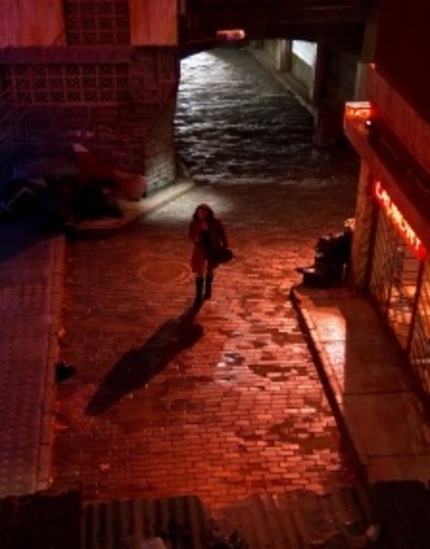Sitges 2011: EL CALLEJON (BLIND ALLEY) Review

Rosa is a young girl from Cuba, working as a maid in a coastal resort hotel. She dreams of a better life as a dancer on a television show, and when she gets a call-back, she is forced to go an all-night laundrette on a gloomy, dead end street to wash her sparkly dresses. There, she meets a handsome man who seems quiet and charming; but as anyone who has watched a film such as this, we should all beware of wolves in sheeps' clothing. And Gabriel does turn out to be a wolf, trapping Rosa inside the laundrette taunting her with threats of killing her sister (with whom she lives nearby) or her, or possibly both. Rosa must survive the night with no hope of rescue.
In a normal slasher film, Rosa would be the girl who is killed fairly early in the film: virginal but naive, not particularly smart and thereby vulnerable to a nasty killer. Rosa survives this film is a combination of luck and skill, which keeps the story very interesting. Ana de Armas plays Rosa with just the right amount of innocence and sex appeal. We first meet her in the opening credits, as she performs her audition with spunk and more than a hint of desperation. No one listens to her when she expresses her desires, her dreams, or her need for help. Diego Cadavid's Gabriel is the perfect foil: he has no psychological trauma to be understood, he's just a monster, and he knows the perfect victim when he sees her. He relishes in his nastiness, and can indeed wait all night to get Rosa, enjoying every moment of her torture.
Trashorras displays an incredible skill for filming architecture, and conveying the affect that space has on a story. The opening scenes show the vast space in which Rosa is barely a speck: a coastal city dedicated to a decadence she can never have. She is relegated to this dark and dank corner, where she is the only spot of colour. As Gabriel traps her in the laundrette, that space becomes both her refuge and her enemy. At times the camera lurks in the corners as if willing Rosa to succumb to fear and death. Other times it closes in on her, as if trying to whisper the secrets to defeating her enemy. It's not easy to keep a film interesting when set in virtually a single location. Trashorras is careful not to waste a frame, and as Rosa's nightmare drags on, he keeps putting the pressure on both victim and killer, and the audience, to think and think fast.
And like any good exploitation film, this is not just about watching a girl get tortured. There are some larger themes at play, mainly loneliness and isolation. With a boyfriend who doesn't respect her, a boss who treats her like dirt, and a city that rejects her, Rosa as an immigrant is constantly being forced into a metaphoric corner - and in this film, a literal one as well. But also like any good exploitation film, El Callejon concentrates on that pretty girl and her killer in a dialogue of love, lust and death, with plenty of blood and scares to keep the audience cheering.

Do you feel this content is inappropriate or infringes upon your rights? Click here to report it, or see our DMCA policy.






